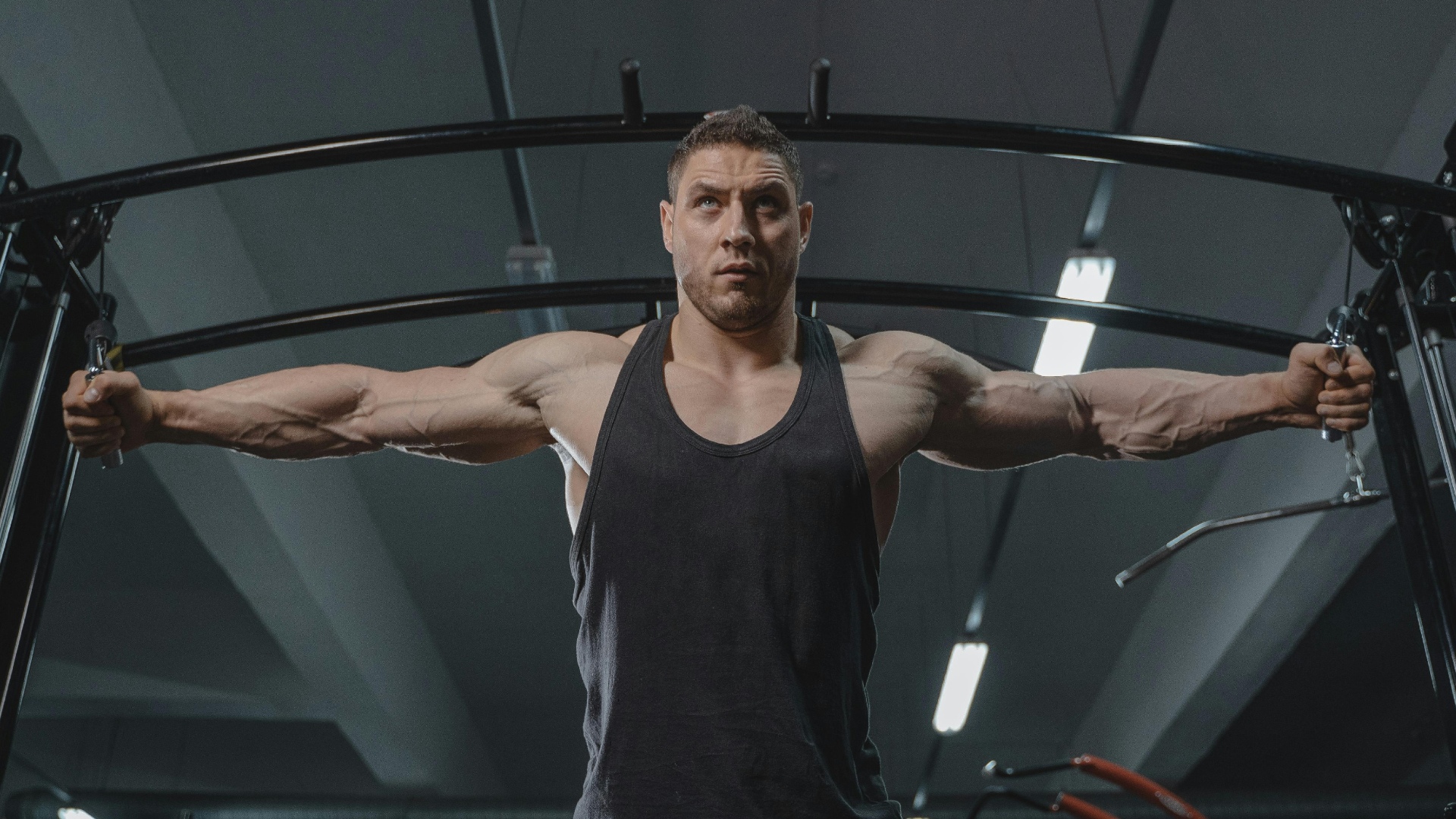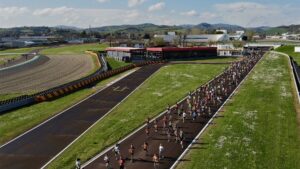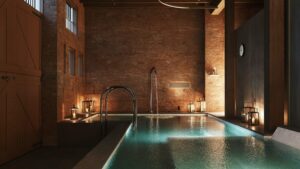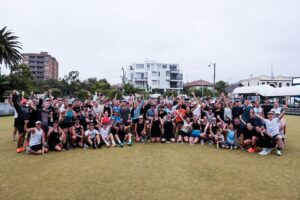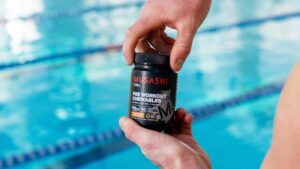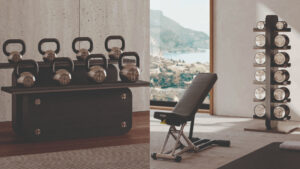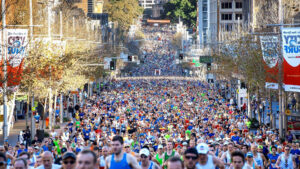Mondays will always be International Chest Day, and for good reason. According to a 2017 survey, a well-sculpted chest is the body part women find the most attractive in men, which means there’s good reason to improve your workout regime to include some of the best chest exercises, in addition to the health benefits.
Jump To:
- Why It’s Important To Train Your Chest
- How To Get A Bigger Chest
- The Best Warm-Up Chest Exercises
- The Best Chest Exercises To Try For Improved Strength & Size
- The Best Cooldown Exercises After A Chest Workout
- The Boss Hunting Fitness Reviewer — Jono Castano, Certificate IV in Fitness, Precision Nutrition Level 1
What Are The Different Chest Muscles?
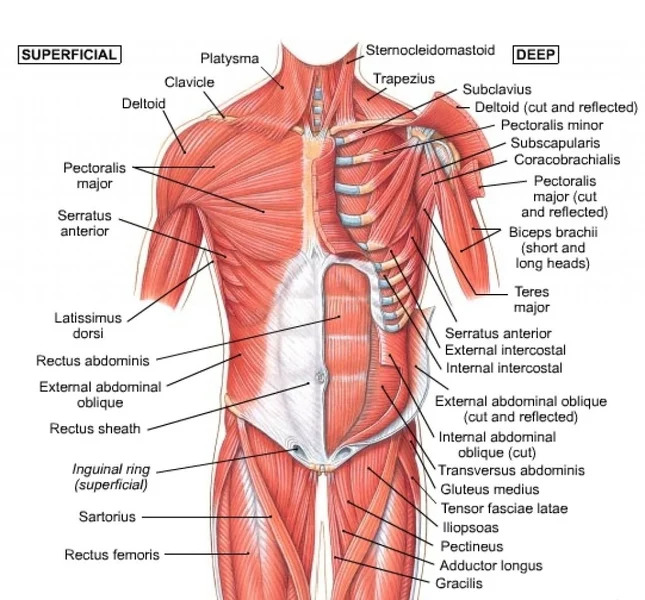
Pectoralis Major
The pectoralis major muscles are the two largest muscles in your upper torso. They are fan-shaped and lie on each side of your chest, with two “heads” that connect to your collarbone and breastbone. (1)
- The clavicular head helps to raise your arm in front of you
- The sternocostal head helps with horizontal arm movements — like hugging someone — and to drop your arms from a forward position.
Pectoralis Minor
The pectoralis minor is a triangular muscle located underneath the pectoralis major and forms the outer wall of the axilla — where the arm connects to the shoulder.
These muscles allow for full mobility of your shoulder blades, such as when you pull your shoulders down or forward, and they also help to elevate your ribs when they contract, which allows air into your lungs when you breathe.
Serratus Anterior
Better known as the “boxer’s muscle”, the serratus anterior is another fan-shaped muscle that helps push your shoulders forward when you need to throw a punch. It also works alongside the pectoralis muscles to help your arms swing forward, or with the trapezius muscles to extend your arms sideways.
Subclavius
The subclavius is a small muscle located between your collarbone and first rib. Although tiny compared to the other muscles that surround your rib cage, this muscle plays an important role in stabilising your shoulder girdle (the bones, tendons, muscle fibres, and ligaments that help connect your arms to your shoulders), as well as preventing collarbone fractures. (2)
The subclavius also helps to control the movements of your collarbone.
Why It’s Important To Train Your Chest
While looking good and feeling confident are great outcomes of a well-developed chest, there’s more reason to focus on it than mere aesthetics. Your chest muscles play a vital role in how you perform everyday tasks, from pushing open doors to almost any whole-arm movements, as well as being a critical element of good posture.
Good posture isn’t just important for being able to stand up straight and present well, but it’s also a sign of a strong muscular core which is important to preventing injury while working out and in the gym. It’s not common that folks skip chest day, but if you are, it’s important you get to work on building a strong chest.
How To Get A Bigger Chest
The standard bench press (3), pec deck machine and bent-forward cable crossover are the top workouts to develop muscle size and lose weight fast. But there’s a lot more to work out your chest than just these three.
It is also important to remember that incorrect techniques can slow down your progress. There’s no point trying to load 5 plates on an Olympic bar to show off your bench press when you struggle to keep your form right. Slow, controlled lifts produce greater results compared to fast ones.
The Best Warm-Up Chest Exercises
1. Cross Body Arm Swings (Warm Up)
- Difficulty: Beginner
- Target muscles: Pecs, serratus anterior, deltoids
- Equipment needed: None
- Sets: 1-2
- Reps: Repeat slowly for 30 seconds and then faster for 30 seconds
- Rest: 10 seconds
Benefits: The cross-body arm swing is a warm-up exercise that will prepare your muscles for heavy-press exercises and can improve your flexibility. It also acts as a great cardiovascular exercise to get your blood flowing and your upper body tendons ready for a powerful chest workout.
- Stand upright, feet shoulder-width apart and knees slightly bent.
- Stretch your arms horizontally to your sides with your shoulder blades pulled together toward your spine.
- Swing your arms straight to your body’s midline, in line with your breastbone, while keeping your pecs and core tight, and have your arms cross over one another.
- Swing your arms back as far as you can.
- Repeat the process and alternate which arm is on top for a more symmetrical stretch.
- The stretch can be further improved by rotating your palms outward (as if hugging someone) as your arms open. Rotate your palms to face each other as your arms cross.
2. PVC Pass-Through (Warm Up)

- Difficulty: Beginner
- Target muscles: Pecs, anterior deltoids, serratus anterior, traps, lats
- Equipment needed: PVC pipe or broomstick (1.5-2 metres in length)
- Sets: 3
- Reps: 10-15
- Rest: 10 seconds
Benefits: The PVC pass-through helps improve the mobility and function of your shoulder and wrist joints. It also targets the surrounding muscles in these areas, improving your overall range of motion.
- Stand with your neck and back straight, feet flat and shoulder-width apart.
- Hold the pipe with a comfortable space between your hands, avoid bending your elbows and keep your palms face down. Keep your glutes squeezed, tailbone tucked in and core tightened.
- With your arms locked, bring the pipe up over your head and back down so that it touches your lower back (or as low as you can without hurting yourself).
- Bring the pipe back to your front with the same movement. This is 1 rep.
A variation of the PVC pass-through is the PVC figure 8 which works your chest muscles, lats and deltoids.
To perform the PVC figure 8, Instead of bringing your arms straight over your head, lift your right arm first so that the pipe is diagonal next to your left side. Bring it down in a circular motion so that the pipe is horizontal across your lower back. Lift with the left arm and bring it over your right shoulder to rest in line with your waist.
3. Weighted Svend Press (Warm Up)
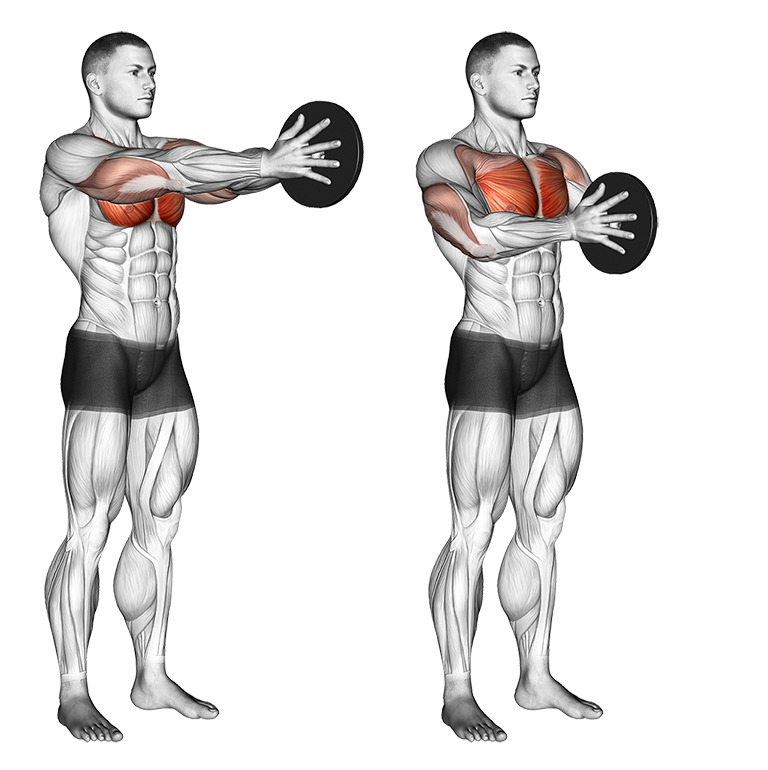
- Difficulty: Beginner
- Target muscles: Pectoralis major, anterior deltoids, biceps, triceps, lats
- Equipment needed: Two weighted plates (5-10kg each)
- Sets: 1-2
- Reps: 15
- Rest: 5-10 seconds
Benefits: This warm-up exercise, named after the 2001 World’s Strongest Man winner, Svend Karlsen, focuses on isolating and building muscle mass and strength primarily for the pectoralis major muscles without adding extra strain to your rotator cuffs or shoulders.
- Stand with your feet shoulder-width apart and pinch together two 5kg (or 10kg) plates between your hands. Keep your back straight and focus on squeezing your hands together as hard as you can, not just holding the plates against each other.
- Hold the plates against your chest with your shoulder blades pressed together.
- Slowly extend your arms straight out and slightly up (roughly in line with your chin) until your elbows are locked.
- Repeat this process with your chest contracting as you press your arms out.
The Svend press can also be used for muscle growth by performing three to four sets with 10-15 reps.
A variation of the weighted Svend press is the C-cable Svend press. This variation involves setting up two cable machines at an equal distance from either side of a bench.
- Lie in a supine position on the bench.
- Pull the cable grips together so that your closed fists touch each other and your chest.
- Keeping your fists together at all times, extend the grips directly above and away from the body.
Check out this video for a more detailed guide to this exercise:
The Best Chest Exercises To Try For Improved Strength & Size
1. Push Up
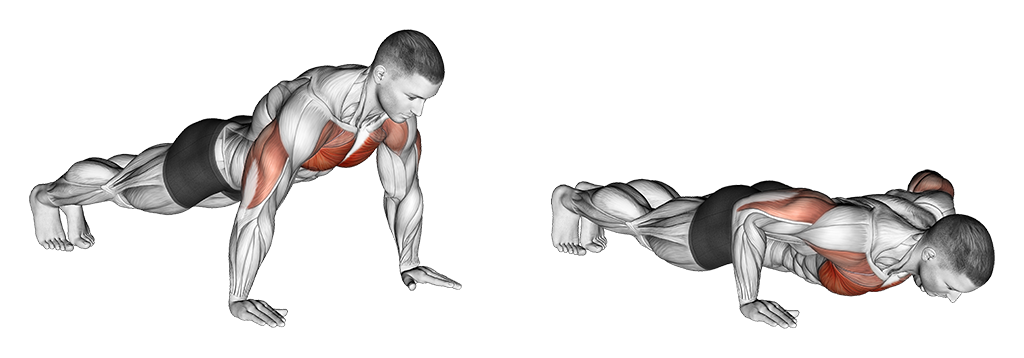
- Difficulty: Beginner
- Target muscles: Pecs, triceps, biceps, abs, glutes
- Equipment needed: None
- Sets: 2-3
- Reps: 10
- Rest: 30 seconds
Benefits: The classic push-up is one of the best chest exercises for beginners, improving both the flexibility and strength of your shoulders as well as your middle and lower back muscles.
Slower push-ups provide constant tension to your muscles and will help you focus on your form, which will also increase your strength and muscle mass. Faster push-ups will help you gain more endurance and you’ll burn more calories per minute.
- With your body parallel to the floor, place your hands and feet shoulder-width apart, your thumbs in line with your breastbone and fingers forward. Your toes should be pointing to the floor.
- Keep your legs, arms and back straight and look forward to lengthening your neck. Keep your elbows tucked inward so that your form looks like an arrow viewed from above and not a T-shape.
- Tighten your abdomen and glutes. Slowly bend your elbows to a 90-degree angle or less and contract your shoulder blades as if you’re pressing a macadamia nut between them.
- Lower yourself until your chest is a fist-size away from the floor. Hold for 2 seconds and press up again, maintaining a straight back and legs.
- Repeat the process and keep your core and back muscles tight.
Since the push-up is an exercise as old as the history of physical training itself, it has evolved with scores of variations over time. (4) One push-up variation we particularly like is the BOSU push-up as it doesn’t just ramp up the difficulty but is also one of the best chest exercises because it forces you to focus on your balance.
- Place your hands on the flat side of an upturned BOSU ball.
- Slowly lower your body towards the base.
- Keep your body and neck straight and inline, and your abs tight.
- Hold for 4 seconds before coming back up.
2. Pec Deck Fly
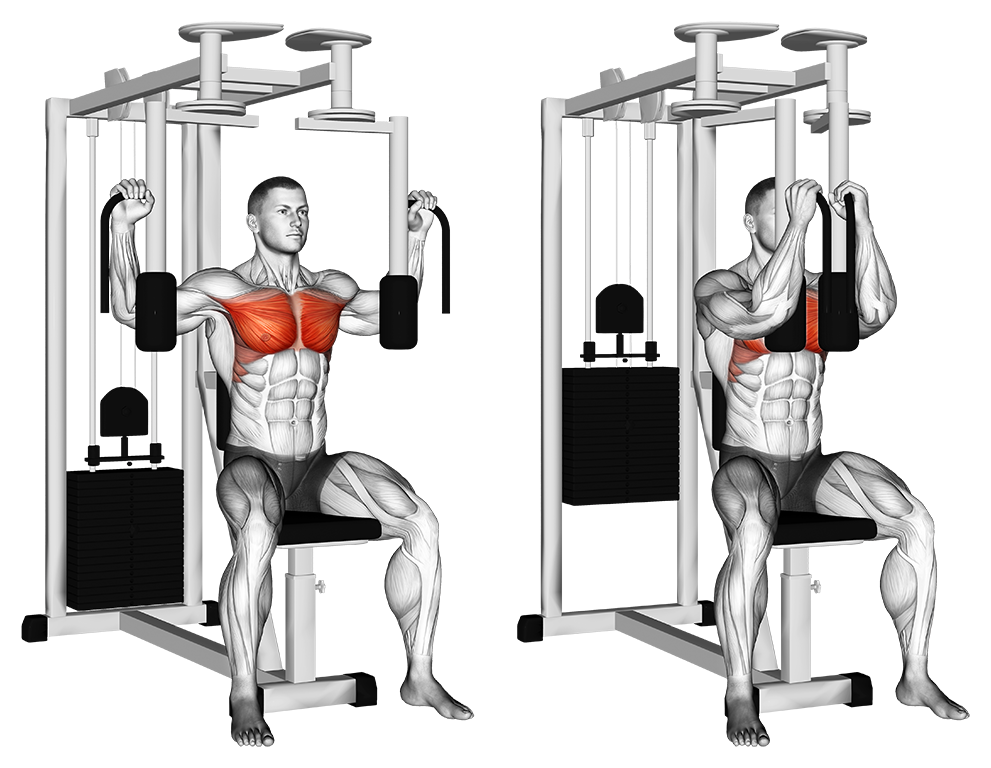
- Difficulty: Beginner
- Target muscles: Pecs, serratus anterior, anterior deltoids
- Equipment needed: Pec deck machine
- Sets: 2-3
- Reps: 7-10
- Rest: 30 seconds
Benefits: As one of the best workout machines for your chest, the pec deck works your pectoralis muscles, and helps to strengthen and stabilise your shoulder blades, arms, and overall core.
When using a machine for chest workouts — or any workout for that matter — always first adjust the seat and handles so they are appropriate to your height and wingspan. In this case, set the handles at chest height.
- Select light to moderate weight for the machine and sit on the seat with your back firmly against the platform and your feet flat on the floor or footrests.
- Grab each handle, palms facing forward, forearms pressed against the padding and elbows bent at 90 degrees. Some machines might have a foot bar that you need to push to release the handles and bring them forward.
- Pull your shoulders down, and back and tighten your abdomen.
- Contract your pecs and exhale as you smoothly squeeze your arms together to the front of your chest until the handles lightly touch. Hold for 2-3 seconds. Keep your back firmly against the platform.
- Inhale as you bring the handles back to the starting position without the weights touching.
- Repeat and re-lock the machine with the foot bar once done.
Although named interchangeably with the lever pec deck fly, the flye machine differs from the pec deck in that it creates a wider space between the elbows when at the tip of the squeeze.
The flye machine provides for straighter and wider arms, where the elbows are slightly bent. Using the same steps as the pec deck, the fly machine produces a deeper stretch of your chest muscles, helping you build muscle mass more effectively than with the pec deck.
Check out this video for a deeper understanding of the differences between the two.
3. Chest Dip
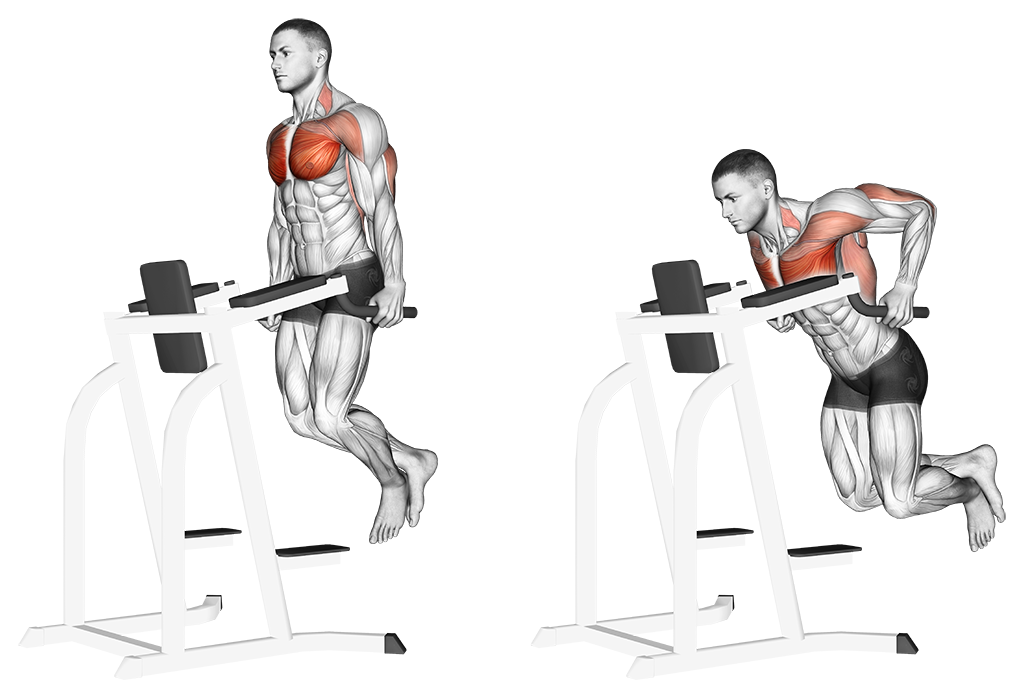
- Difficulty: Intermediate
- Target muscles: Pecs, deltoids, triceps, lats, rhomboids, levator scapulae, teres
- Equipment needed: Dip machine or parallel bars
- Sets: 3
- Reps: 8-12
- Rest: 30 seconds
Benefits: The chest dip, like the push-up, tests the body’s ability to handle its own weight and targets a big portion of your upper body muscles. Without a doubt, it’s one of the best chest exercises because of this reason.
During the chest dip, your hands are slightly wider than shoulder width, your elbows flared out and your chest tilted forward. This stands in contrast to a normal dip where you’re positioned more upright with your feet under you and your elbows tucked in.
- Stand in between the dip machine handles or parallel bars and grab the handles with your palms facing inwards.
- Lift yourself off the floor by straightening your arms. Press your shoulder blades down and lean forward with your chest at a slight downward angle. Lift your feet so that they’re behind your body. You can cross them for greater stability.
- Flare your elbows out and bend them while still leaning forward to descend.
- Lower yourself until your arms are at a 90-degree angle, hold for 2 seconds and push up again.
- Repeat.
A classic advanced variation of the chest dip is the weighted dip. It is for those who find doing bodyweight dips a walk in the park and is one of the best chest exercises in the game. To do a weighted dip, simply tie a weight to your waist with a rope, chain, or weighted dip belt, and repeat the previously mentioned steps.
4. Chest Press

- Difficulty: Beginner
- Target muscles: Pecs, biceps, deltoids, lats
- Equipment needed: Chest press machine
- Sets: 3-4
- Reps: 8-12
- Rest: 90 seconds
Benefits: The chest press machine is easy for gym newbies as it offers a safe and simple way to load up your chest and upper arm muscles, while also working well for more experienced trainers who want to train until failure.
Depending on the weights you add, the chest press can be used as a warm-up or cool-down workout. Remember to adjust your seat so the handles are at chest height.
- After adding your desired weight, sit with your back straight against the back padding, feet shoulder-width apart, and release the foot bar.
- Grab the handles, with your wrists in line with your forearms, and press outward slowly without locking your elbows.
- Exhale during this movement and keep your back and head steady against the padding.
- Hold for 4 seconds and inhale as the handles come slowly back until they’re in line with your chest.
- Repeat and re-lock the machine with the foot bar once done.
5. Barbell Bench Press
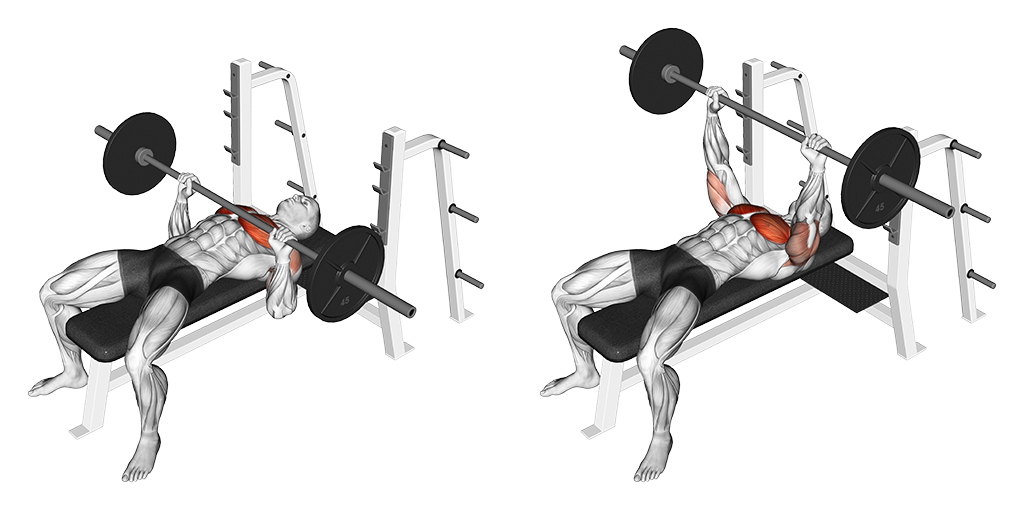
- Difficulty: Beginner
- Target muscles: Pectoralis major, triceps, anterior deltoids, traps, serratus anterior
- Equipment needed: Barbell, bench
- Sets: 3
- Reps: 5-10
- Rest: 45-90 seconds
Benefits: The bench press is not just one of the best chest exercises to create a bigger torso, it also helps to improve endurance and tone the upper body, arm, and shoulder muscles. One study also found that bench pressing could help increase bone density and neuromuscular performance. (5)
To perform the bench press:
- Lie flat on the bench so that your eyes are aligned with the barbell and squeeze your shoulder blades. This will create a natural arc in your lower back, which is desired.
- Grip the barbell with your hands slightly wider than shoulder-width apart and your arms at a 45-degree angle from your torso. Tighten your core and press your feet firmly into the floor.
- Lift the barbell off its rack and directly over your breastbone.
- Inhale and slowly lower it to just above your chest. Keep your wrists straight and directly above your elbows. Your forearms should be perfectly vertical at the stopping point.
- Exhale as you slowly press the barbell up. Lock your elbows for a full range of motion and to rest between reps, or keep them slightly bent to provide constant tension.
- Repeat and lock your elbows with the last rep before replacing the barbell back on the rack.
The barbell press has a lot of variations including the incline and the decline barbell press. The incline bench should be angled upward between 45-60 degrees or declined to between 15-30 degrees. Press the weight upward over your eyes or slightly higher, with elbows extended to 45 degrees.
For more information on both variations, check out our guide to the perfect bench press workout.
6. Flat Dumbbell Bench Press
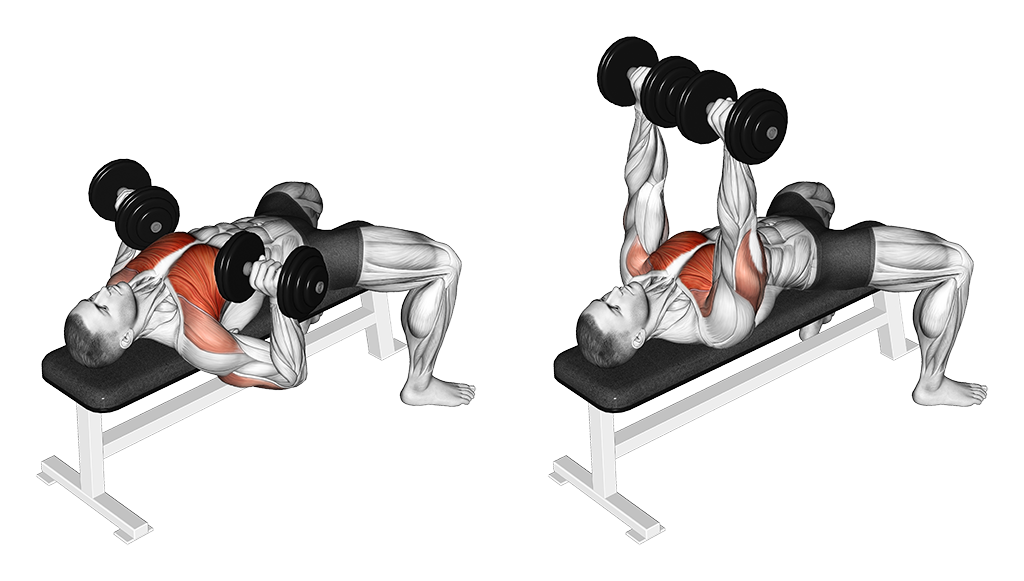
- Difficulty: Intermediate
- Target muscles: Pecs, triceps, anterior deltoids
- Equipment needed: Dumbbells, bench
- Sets: 2-3
- Reps: 8-12
- Rest: 45-90 seconds
Benefits: The dumbbell bench press uses each arm independently, making it one of the best chest exercises as it creates a more dynamic movement that can help improve muscle asymmetries if you’ve favoured one side of your body during training. It also provides a greater range of motion than the barbell bench press.
- Sit at the end of a flat bench with a dumbbell in each hand on your knees.
- Lay down and hold them above your shoulders, palms facing forward, back flat, arms extended, and your shoulders pressed down. Make sure to tighten your core.
- Inhale as you slowly lower the dumbbells to your sides, either stopping level with your chest or before your shoulders start lifting. Your arms should be at a 45-degree angle from your torso.
- Exhale as you push the dumbbells up and towards each other with a slight bend in your elbows, and squeeze your chest as you do this.
- Repeat and bring the dumbbells to the floor when you are done.
7. Dumbbell Fly

- Difficulty: Intermediate
- Target muscles: Pecs, deltoids, rhomboid, teres
- Equipment needed: Dumbbell, bench
- Sets: 3-4
- Reps: 4-8
- Rest: 45-90 seconds
Benefits: The dumbbell fly helps to open your chest and shoulder muscles, and can help reduce upper back pain and improve posture, while also requiring each arm to move dynamically and independently. Here’s how to do it:
- Sit at the end of a flat bench with a dumbbell in each hand resting on your knees.
- Lay down and hold them above your chest, palms facing each other and arms slightly bent.
- Inhale as you slowly lower the dumbbells in an open swinging motion to your sides until they’re level with your chest. Don’t change the bend by your elbows, keep your core tight, and your body flat on the bench.
- Exhale and compress your chest as you bring your arms back to the starting position with the same swing motion. Don’t let the dumbbells touch.
- Hold for 2 seconds and repeat. Bring the dumbbells to your knees once done.
Similar to the barbell press, you add variations to the dumbbell fly such as the decline and incline dumbbell fly. We recommend trying the BOSU though for great results.
Instead of using a bench, lean on a BOSU ball with your back and focus on keeping your body straight and feet planted on the floor while following the same steps as outlined above. As well as being one of the best chest exercises, this will help test your core strength and coordination.
8. Landmine Press
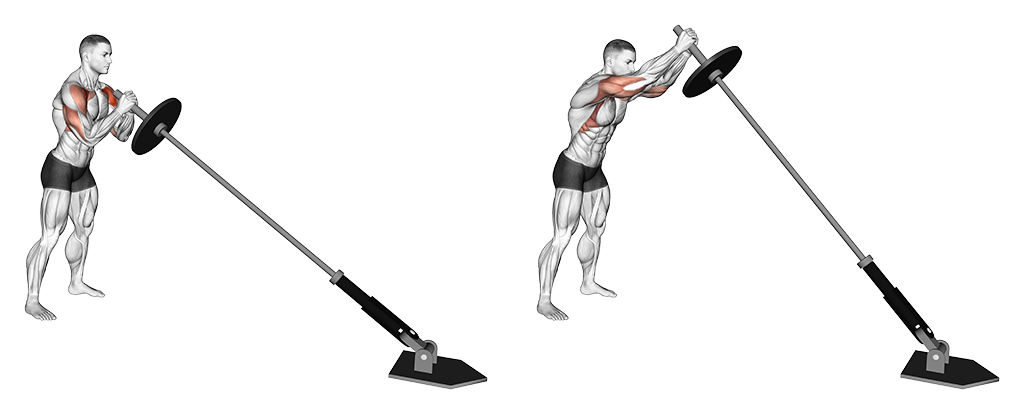
- Difficulty: Intermediate
- Target muscles: Pecs, deltoids, triceps, teres, obliques, abs, glutes
- Equipment needed: Anchored barbell (weight optional)
- Sets: 3-5
- Reps: 8-15
- Rest: 45-90 seconds
Benefits: The landmine press can be done with both hands or one at a time, with the single-arm version engaging your core muscles more and isolating one arm at a time. This allows you to uncover any muscle imbalances, while also focusing on core and shoulder stability, which can help prevent shoulder injuries.
- With feet shoulder-width apart, lift the barbell up to your chest.
- Tighten your core and glutes, and lean forward slightly with your hips.
- Inhale and press the barbell upwards and forward in a straight line until your arms are fully extended. Keep your elbows slightly bent.
- Tighten your chest when pressing forward.
- Hold for 2 seconds and bring it back to your chest while breathing out.
- Repeat by switching to the other arm if not done with both arms initially.
9. Cable Crossover
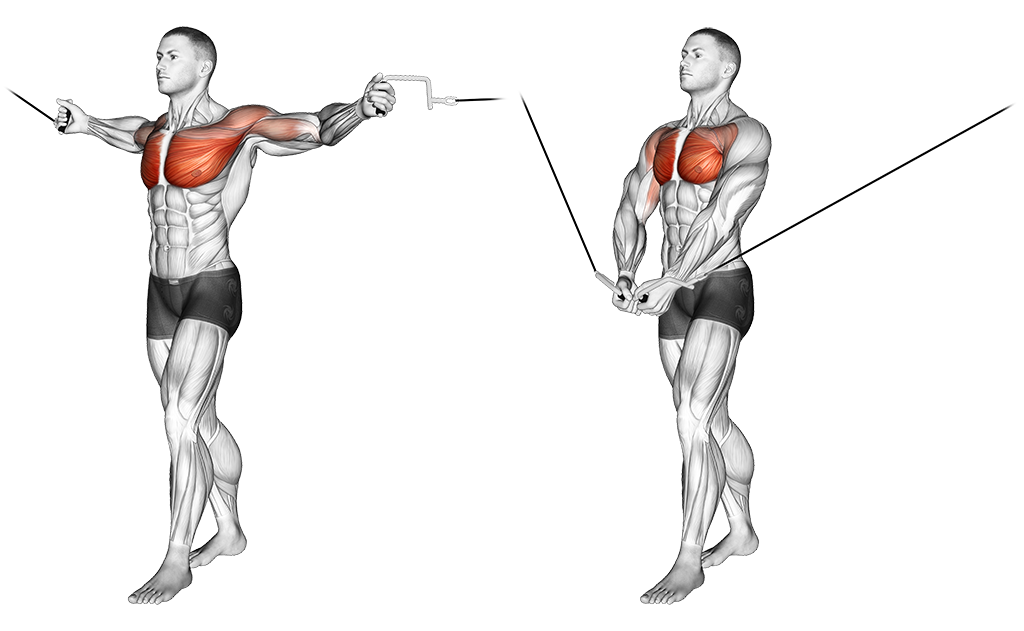
- Difficulty: Intermediate
- Target muscles: Pecs, external and clavicular heads, abs, obliques, erector spinae, anterior deltoids, biceps, triceps
- Equipment needed: Cable machine or resistance band
- Sets: 3
- Reps: 8-12
- Rest: 30-45 seconds
Benefits: Cable machines are great because they target your upper, middle, and lower chest muscles depending on where you set the pulleys. Constant tension from the cables also prevents energy from being wasted during exercise and your muscles develop equally because each arm is used separately.
To perform a cable crossover, follow these steps:
- Attach D-handles to pulleys and then set the height of the handles to be slightly lower than your shoulders.
- Grab the handles and step forward with one foot, feet shoulder-width apart. Your hands should be lower than your shoulders and elbows slightly bent.
- Slowly bring your arms together, still slightly bent, in a wide downward arc that lines up with your belly button. Keep your core tight and your chest contracted.
- Cross your hands to add emphasis to the serratus anterior muscles.
- Hold for 4 seconds and return slowly to the starting position.
10. Archer Cliff-Hanger Pull-Up
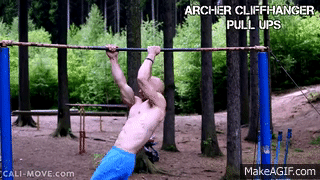
- Difficulty: Advanced
- Target muscles: Pecs, traps, deltoids, lats, abs, obliques
- Equipment needed: Pull-up bar
- Sets: 2-3
- Reps: 6-10
- Rest: 60 seconds
Benefits: The archer cliff-hanger pull-up is an advanced combination of the archer and cliff-hanger (or “commando”) pull-ups used in callisthenics training to target the chest and improve shoulder stability. It also requires more balance to perform successfully, making them more mentally engaging if you’re new to the exercise.
- Grip the pull-up bar with one hand behind the other (palms facing each other).
- Shift your arms so that the front arm is straightened horizontally and the back arm is bent.
- Keep your body in a straight line relative to the bar and lift your legs up to create a 90-degree angle with your body. Don’t rotate or twist your body during this chest workout.
- Tighten your chest and glutes as you slowly pull yourself up with the bent arm until the bar touches the shoulder of that arm. Contract your shoulder blades with the pull-up.
- Slowly move back down until the bent arm’s elbow is only slightly bent and repeat.
- Keep the bent arm fixed and the straight arm straight for a few reps before switching arms.
For a slightly easier variation of this exercise, tie a resistance band to the pull-up bar and hook one foot in. Repeat the above steps but bend both arms instead of just one for easier movement.
The Best Cooldown Exercises After A Chest Workout
1. Kneeling Chest Opener Stretch (Cooldown)
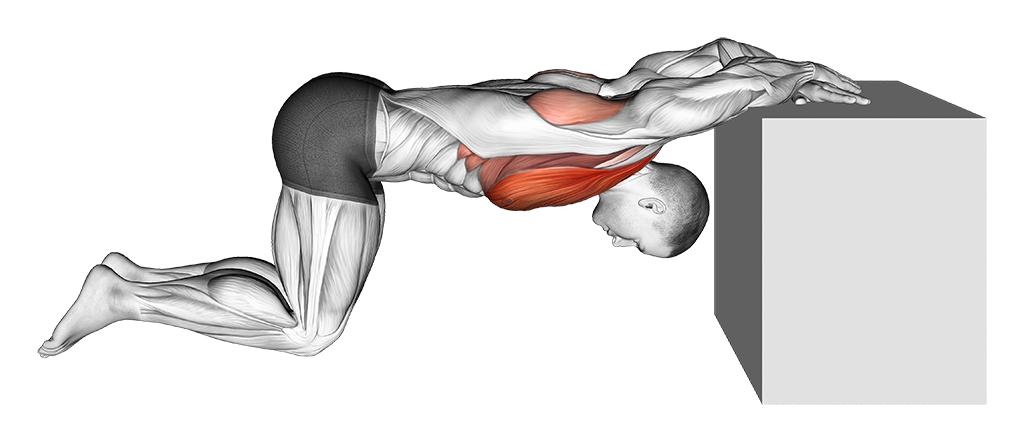
- Difficulty: Beginner
- Target muscles: Pecs, lats, serratus anterior
- Equipment needed: Chair or bench
- Sets: 1
- Reps: 2
- Rest: 20 seconds
Benefits: Because your shoulders and chest are stretched in this kneeling position, this move can improve your overall range of motion, as well as joint flexibility, which is critical to improving your strength without injuring yourself.
- Sit on your knees at arm’s length to a chair or flat bench.
- Place your hands on the flat surface, palms down and arms crossed over.
- Put your head between your arms and lower your head slightly. Reach forward further without overarching your back.
- Hold for 30-180 seconds and release.
2. Bent-Arm Wall Stretch (Cooldown)
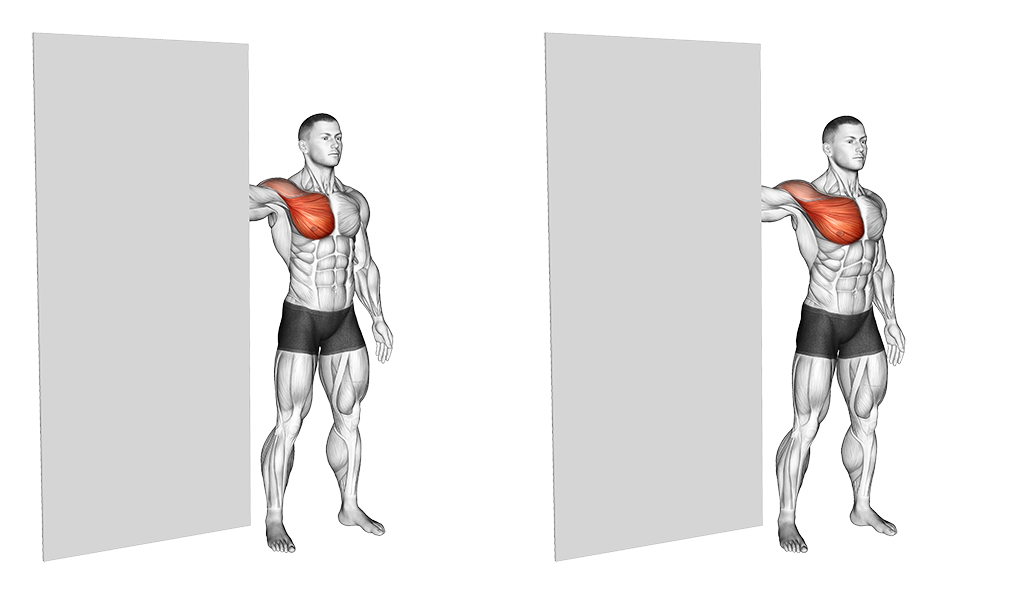
- Difficulty: Beginner
- Target muscles: Pecs, deltoids
- Equipment needed: Wall or door
- Sets: 2
- Reps: 2
- Rest: 5 seconds
Benefits: This is a great stretch to target your chest muscles individually and can act as one of the quickest and best lunch break exercises to improve flexibility. This stretch is extremely popular with competitive swimmers as a result of its success in improving dynamic flexibility. Moving your arm up or down will target different sections of your chest.
- Stand at the end of a door or wall with your right foot half a metre in front of the left, legs shoulder-width apart and knees bent.
- Place the inside of your right arm against the door at a 90-degree angle, with your elbow level with your shoulder and your palm against the door.
- Gently press your chest forward and hold for 1 minute.
- Switch around and repeat with your left side.
3. Seated Shoulder Extension Stretch (Cool Down)
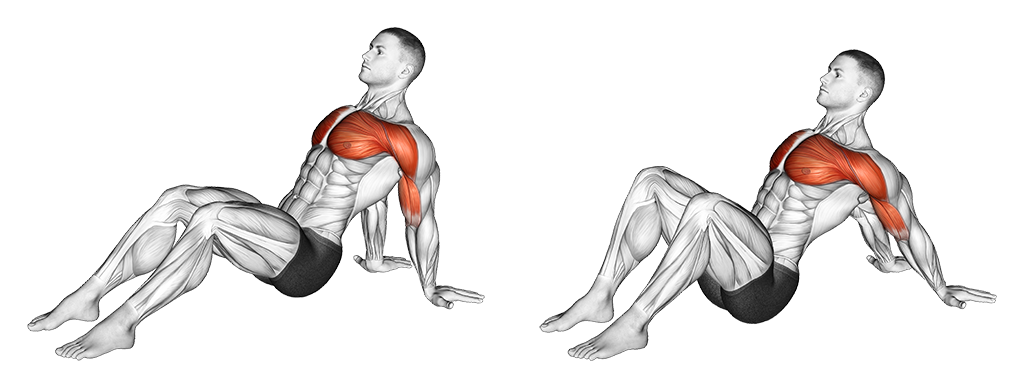
- Difficulty: Beginner
- Target muscles: Pecs, anterior deltoids, lats, biceps
- Equipment needed: None
- Sets: 2
- Reps: 2
- Rest: 5 seconds
Benefits: Don’t let the name fool you, this stretch works your chest and arms as well as your shoulders and is great to enhance recovery for your next workout. It also helps to reset your posture because of the seated position you’re in.
- Sit on the ground with your knees bent at 90 degrees and feet flat.
- Lean back and place your arms behind you, palms down. Press your chest up and shoulders down.
- Hold for 1-2 minutes and release.
Citations
- Three-dimensional study of pectoralis major muscle and tendon architecture, Clinical Anatomy – Wiley Online Library, 16 March 2009.
- The anatomy and variation of the coracoid attachment of the subclavius muscle in humans, Journal of Anatomy – Wiley Online Library, 25 October 2021.
- Time course for arm and chest muscle thickness changes following bench press training, Interventional Medicine and Applied Science, 1 Dec 2012.
- Comparison of muscle activation using various hand positions during the push-up exercise, Journal of Strength and Conditioning Research, August 2005.
- Bench Press exercise: the key points, The Journal Of Sports Medicine And Physical Fitness, 13 May 2014.
The Boss Hunting Fitness Reviewer — Jono Castano, Certificate IV in Fitness, Precision Nutrition Level 1
Jono Castano is a Sydney-based celebrity personal trainer and certified nutrition coach who specialises in fitness, training, workouts and diet plans. He is the co-founder of the popular Acero fitness brand and fitness app and has become well-known for his extensive work with noted figures like Rebel Wilson, Jessica Mauboy, Lincoln Lewis, Joel Creasy, and The Veronicas.
Jono has built a large social media following with over 800,000 subscribers on Instagram. He has also been profiled by publications such as Men’s Health and has become one of the most recognisable fitness instructors in Australia.
- Location: Sydney, Australia
- Credentials: Certificate IV in Fitness, Precision Nutrition Level 1
- Expertise: Fitness, Training, Personal Training, Workouts, Diet Plan
Editor’s Note: The fitness content on Boss Hunting is informative in nature, but it should not be taken as medical or professional fitness advice. When starting a new training regimen and/or diet, consulting with a trusted medical professional or trainer is always a good idea.
Did you enjoy this article on the best shoulder exercises? Check out a few of Boss Hunting’s other workout guides below:
- The 15 Best Ab Workout Exercises
- The 12 Best Shoulder Exercises For Improved Strength & Size
- The 15 Best Exercises For The Perfect Leg Workout
- The 15 Best Bicep Exercises & Workouts For Men
- How To Bench Press [A 101 Guide For The Average Bloke]
- The 21 Best Rear Delt Exercises For Boulder Shoulders
- The 11 Best Tricep Exercises For Improved Strength & Size
- The 15 Best Exercises For The Perfect Leg Workout
- The 9 Best Lat Exercises For When Size Is The Prize
- The 16 Best Oblique Exercises & Workouts For Men
- The 13 Best Trap Exercises & Workouts For Men
- The 10 Best Forearm Exercises & Workouts For Men
- 5 First Time Marathon Tips From Olympic Runner Brett Robinson
- The 25 Best Dumbbell Exercises & Workouts You Don’t Need A Gym For
- Why The 75 Hard Challenge Can Work For You
For more information to consider about diet, nutrition and, fitness equipment, check out below:
- Does Intermittent Fasting Actually Work? We Tested It Out
- How To Lose Weight Fast: 10 Simple Tips To Shed Fat More Efficiently
- The 7 Best Massage Guns You Can Buy In Australia
- The 13 Best Exercise Bikes To Stay Fit This Winter
- The 22 Best Mountain Bikes Money Can Buy Right Now
- The 16 Best Electric Bikes In Australia
- 8 Best Tennis Shoes for Men in Australia
For some celebrity inspiration, check out our celebrity workout guides right here:
- Henry Cavill’s Workout Routine Will Unleash Your Inner Superman
- The Workout That’ll Get You ‘Gladiator 2’ Ripped Like Paul Mescal
- The Chris Hemsworth Workout & Diet Plan Is Inhuman
- Jake Gyllenhaal’s Workout & Diet Plan To Get ‘Road House’ Ripped
- How Jeremy Allen White Got Calvin Klein Model-Jacked
- Joe Rogan’s Workout & Diet Plan Isn’t For The Faint-Hearted
- How Hugh Jackman Trained For His MCU Return In ‘Deadpool & Wolverine’
- Daniel Craig’s Military-Inspired Workout For ‘No Time To Die’
- How Michael Jordan’s Personal Trainer Helped Him Achieve GOAT Status
- The Bruce Lee Workout That Made His Rig Famous
- The Rock’s Intense Workout For ‘Hobbs & Shaw’ Will Bring You To Your Knees
For the best places to improve your health and fitness, check out our recommendations here:
